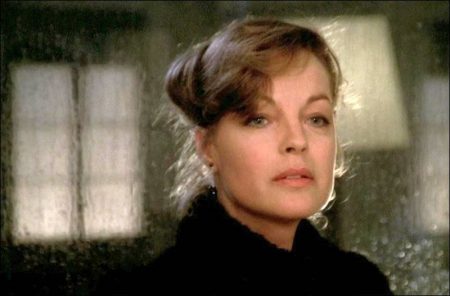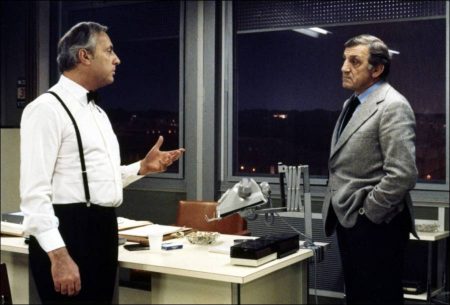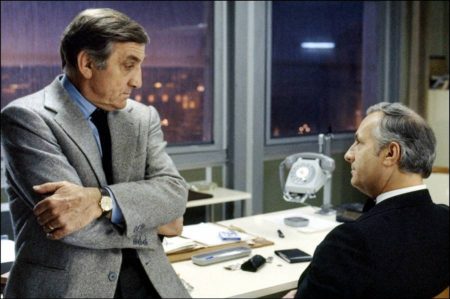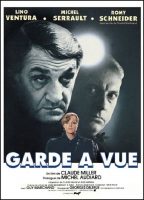In Garde à vue, Inspector Gallien (played by Lino Ventura) investigates the rape and murder of two young girls and targets attorney Jerome Martinaud (played by Michel Serrault), slowly breaking him down psychologically until he confesses to the crimes, even though he did not commit them. Director Miller emphasizes his message about investigatory detention in France by showing that even an experienced attorney can become an unintended victim. Garde à vue is still available only in French, but fortunately the film was re-made in the United States as Under Suspicion.
Garde à Vue (also known as The Inquisitor) is a 1981 French psychological crime drama directed by Claude Miller and starring Romy Schneider, Michel Serrault, Lino Ventura and Guy Marchand. It is based on the British novel Brainwash, by John Wainwright. It won the César Award for Best Writing, Best Actor and Best Supporting Actor. The film had 2,098,038 admissions in France and was the 17th-most-attended film of the year.
Screenwriter Michel Audiard discovered John Wainwright’s novel, published in Série noire in 1980, and brought the project to Les Films Ariane. They suggested it to Claude Miller who decided to make Martinaud’s character more psychologically complex than he was in the book. Miller asked Lam Lê to create a complete storyboard for the film before the shooting. Filming started January 27, 1981 and wrapped March 13, 1981. The picture was filmed entirely in a studio and in chronological order.

Film Review for Garde à Vue
When his second film, Dites-lui que je l’aime (1977), spectacularly bombed at the French box office, Claude Miller very nearly gave up filmmaking for good. For the next four years, he worked in advertising and only returned to directing when producer Georges Dancigers invited him to adapt John Wainwright’s American crime novel Brainwash.
As it turned out, that film – Garde à vue was a major critical and commercial success, and is widely regarded as Miller’s best film. It attracted an audience of 2.1 million in France and was nominated for eight Césars in 1982, in categories that included Best Film and Best Director. Michel Serrault took the Best Actor César and the film also won awards for Best Screenplay, Best Editing and Best Supporting Actor (Guy Marchand). It was this unexpected triumph that convinced Miller to persevere with his filmmaking career and established him as one of France’s most promising auteur filmmakers. The film also marked the screen debut of the actress singer Elsa Lunghini, who, five years later, became a chart-topping singer in France at the age of 13.
On the face of it, Garde à vue would appear to be a pretty routine police procedural drama, with a plot that has barely enough substance to fill out an average episode of Columbo. But, as its story demonstrates, appearances can be very misleading. Far from being a conventional crime drama, the film is actually a dark and complex study in deceit and delusion, in which the usual policier ingredients turn out be almost incidental to the central drama. Scripted and directed with astonishing economy and precision, Garde à vue is one of the most compelling French crime films of the 1980s, and certainly one of the bleakest. Stephen Hopkins’s 2000 remake, Under Suspicion, which starred Gene Hackman and Morgan Freeman, can scarcely hold a candle to this stylish minimalist masterpiece.
What is most striking about this film is its apparent narrative simplicity. Most of the film functions almost as a two-handed stage play, in which the two opposing protagonists – police inspector Gallien and his number one suspect Martinaud – act out the psychological equivalent of a Mexican standoff. Stunning performances from Lino Ventura and Michel Serrault, two of French cinema’s finest actors of the period, coupled with some remarkably incisive screenwriting, render Gallien’s mental tussle with Martinaud utterly spellbinding.
As the relentless mind games proceed, the accused and his accuser draw us into some very dark places, each chipping away at the other’s implacable mask so that we may glimpse the psychological flaws that lie beneath.  Is Gallien right to think that Martinaud is the guilty man, or is he wilfully deluding himself so that he can score an easy victory to compensate for his professional and personal failings? Does Martinaud see Gallien’s insecurity and is he playing on this for his own advantage? Only one thing is clear in this battle of wills: each man appears to need the other, but for what purpose…?
Just when the narrative reaches a seemingly irresolvable impasse another character enters the fray – Martinaud’s wife, magnificently portrayed by Romy Schneider in her penultimate (and most enigmatic) screen appearance – and things take an even darker turn. Yet there is still one major plot twist to come, and instead of the anticipated happy ending we are hurled even deeper into the abyss. The expression that is carved onto Ventura’s well-worn features at the very end of the film perfectly captures what the spectator feels – horror, consternation and incredulity. The human psyche, we realise, is the mystery that can and Claude Miller will frequently remind us of this fact in his subsequent films.
Garde à Vue (1981)
Directed by: Claude Miller
Starring: Michel Serrault, Lino Ventura, Guy Marchand, Romy Schneider, Pierre Maguelon, Annie Miller, Didier Agostini, Patrick Depeyrrat, Serge Malik, Mathieu Schiffman, Elsa Lunghini
Screenplay by: Claude Miller, Michel Audiard, Jean Herman
Production Design by: Eric Moulard
Cinematography by: Bruno Nuytten
Film Editing by: Albert Jurgenson
Art Direction by: Lâm Lê
Makeup Department: Catherine Demesmeaker
Music by: Georges Delerue
MPAA Rating: None.
Distributed by: Tamasa Distribution
Release Date: September 23, 1981
Views: 279


